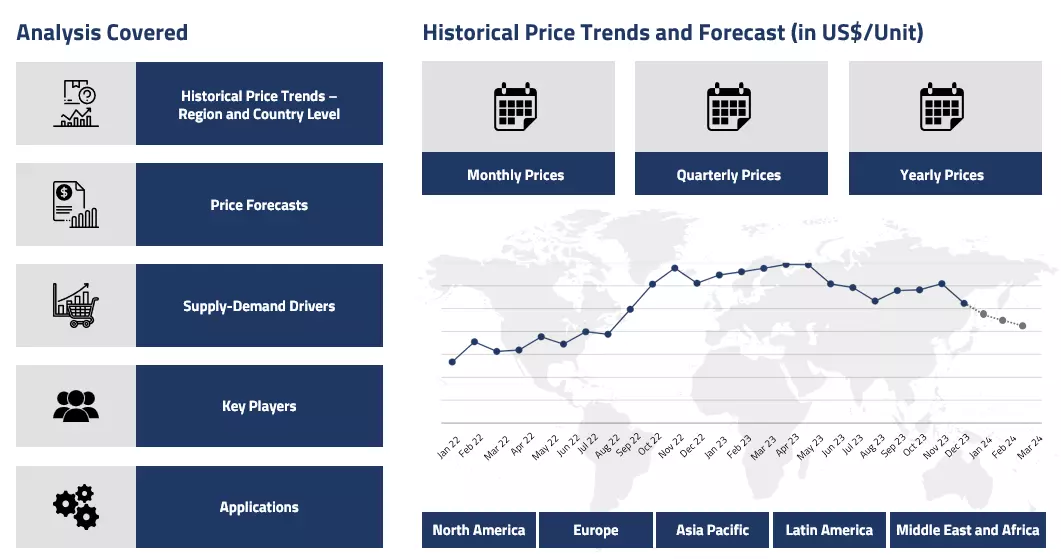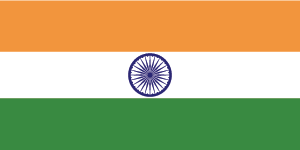Product
Paper Cups Price Trend and Forecast
Paper Cups Price Trend and Forecast
Paper Cups Regional Price Overview
Get the latest insights on price movement and trend analysis of Paper Cups in different regions across the world (Asia, Europe, North America, Latin America, and the Middle East & Africa).
Paper Cups Price Trend for the Year 2023
Paper Cup prices were observed to be oscillating throughout the said period of the year 2023. Paper cup prices usually depend on the feedstock paper and paper pulp prices. During the first half of the year, the prices mostly tilted downwards as the rapid digitization severely affected the growth of paper consumption from the writing and printing industries.
Paper Cups Price Chart

Please Login or Subscribe to Access the Paper Cups Price Chart Data
This reduced the upstream cost pressure a little and dwindled the paper cup price trend by impacting their manufacturing costs. However, around the fourth quarter, as the paper demands rose around the festival seasons, the upstream costs too started surging as the downstream consumption rose from the packaging and shipping industries.
The biodegradability associated with paper also helped popularize paper cups; however, these cups have a very thin layer of plastic in them to increase their efficiency. Albeit a rising demand trajectory is being seen for the paper cups which is pushing the price curve in a positive direction, however, the extensive fall in feedstock paper prices is causing it to recede again. Overall, the price trend was observed to remain afloat during the year 2023.
Analyst Insight
According to Procurement Resource, not much change is anticipated in the paper cup market trends going forward as well. The prices are expected to totter around a similar trajectory.
Paper Cups Price Trend for the Second Half of 2022
The worldwide commerce of goods related to forests has been negatively impacted by the current economic and political dynamics. The price of pulp and consequently, products related to paper, reached previously unheard-of heights as a result of double-digit inflation, rising operating costs, and the approaching prospect of a recession.
Paper cups' costs increased along with a rise in demand as a result of India's impending ban on single-use plastics. Paper cups are 50% more expensive than single-use plastic cups. At the beginning of the third quarter, the prices saw an exponential rise. As a result, throughout the aforementioned time, the price trend for paper cups remained on the stronger side of the scale.
Analyst Insight
Given the current market dynamics the prices of paper cups are expected to increase in the coming months. The rise in demand for paper cups in the market is the major driver of the prices.
Paper Cups Price Trend for the First Half of 2022
With the current economic and political dynamics, the international trade of forest-related products has been affected adversely. The double-digit inflation amid the surging operating costs and the looming threat of recession caused the pulp prices and thus, paper-related products to reach unprecedented highs. The prices of hardwood pulp averaged 6986 RMB/MT (April) in the Chinese domestic market.
With the upcoming single-use plastic ban in India, the prices of paper cups shot up with an increase in demand. The price of paper cups is 50% costlier than single-use plastic cups. One pack of 50 paper cups which cost 120 INR at the beginning of June surged to 150 INR at the end of the month. Hence, the price trend of paper cups remained on the stronger side of the scale throughout the said period.
Procurement Resource provides latest prices of Paper Cups. Each price database is tied to a user-friendly graphing tool dating back to 2014, which provides a range of functionalities: configuration of price series over user defined time period; comparison of product movements across countries; customisation of price currencies and unit; extraction of price data as excel files to be used offline.
About Paper Cups
Paper cups are disposable cups made of paper, often coated with wax to prevent the water from leaking. Paper cups are primarily designed for single use and disposal as very little recycled paper is used to make paper cups because of strict health guidelines and contamination concerns. Since most paper cups are coated with polyethene, separating the coating is difficult during the recycling process. Only a few dedicated facilities can do so; hence, a major portion of paper cups are taken to landfills or incinerated.
Paper Cups Product Details
| Report Features | Details |
| Product Name | Paper Cups |
| HS CODE | 48236900 |
| Industrial Uses | Food and Beverages |
| Synonyms | Dixie Cups |
| Supplier Database | Dart Container Corporation, Pactiv LLC, Letica Corporation, Georgia-Pacific LLC |
| Region/Countries Covered | Asia Pacific: China, India, Indonesia, Pakistan, Bangladesh, Japan, Philippines, Vietnam, Iran, Thailand, South Korea, Iraq, Saudi Arabia, Malaysia, Nepal, Taiwan, Sri Lanka, UAE, Israel, Hongkong, Singapore, Oman, Kuwait, Qatar, Australia, and New Zealand Europe: Germany, France, United Kingdom, Italy, Spain, Russia, Turkey, Netherlands, Poland, Sweden, Belgium, Austria, Ireland Switzerland, Norway, Denmark, Romania, Finland, Czech Republic, Portugal and Greece North America: United States and Canada Latin America: Brazil, Mexico, Argentina, Columbia, Chile, Ecuador, and Peru Africa: South Africa, Nigeria, Egypt, Algeria, Morocco |
| Currency | US$ (Data can also be provided in local currency) |
| Supplier Database Availability | Yes |
| Customization Scope | The report can be customized as per the requirements of the customer |
| Post-Sale Analyst Support | 360-degree analyst support after report delivery |
Note: Our supplier search experts can assist your procurement teams in compiling and validating a list of suppliers indicating they have products, services, and capabilities that meet your company's needs.
Paper Cups Production Process
- Production of Paper Cups from Pulping, Bleaching, and Heating
The food-grade paperboard is turned into reels, printed, and cut into cup sidewall blanks, also called cup boards. These blanks or boards are inserted into the cup-forming machines, and the seams are heated to make the cups liquid-proof.
Methodology
The displayed pricing data is derived through weighted average purchase price, including contract and spot transactions at the specified locations unless otherwise stated. The information provided comes from the compilation and processing of commercial data officially reported for each nation (i.e. government agencies, external trade bodies, and industry publications).
Assistance from Experts
Procurement Resource is a one-stop solution for businesses aiming at the best industry insights and market evaluation in the arena of procurement. Our team of market leaders covers all the facets of procurement strategies with its holistic industry reports, extensive production cost and pre-feasibility insights, and price trends dynamics impacting the cost trajectories of the plethora of products encompassing various industries. With the best analysis of the market trends and comprehensive consulting in light of the best strategic footstep, Procurement Resource got all that it takes.
Client's Satisfaction
Procurement Resource has made a mark for itself in terms of its rigorous assistance to its clientele. Our experienced panel of experts leave no stone unturned in ensuring the expertise at every step of our clients' strategic procurement journey. Our prompt assistance, prudential analysis, and pragmatic tactics considering the best procurement move for industries are all that sets us apart. We at Procurement Resource value our clients, which our clients vouch for.
Assured Quality
Expertise, judiciousness, and expedience are the crucial aspects of our modus operandi at Procurement Resource. Quality is non-negotiable, and we don't compromise on that. Our best-in-class solutions, elaborative consulting substantiated by exhaustive evaluation, and fool-proof reports have led us to come this far, making us the ‘numero uno' in the domain of procurement. Be it exclusive qualitative research or assiduous quantitative research methodologies, our high quality of work is what our clients swear by.
Table Of Contents
Our Clients

Get in Touch With Us

UNITED STATES
Phone:+1 307 363 1045

INDIA
Phone: +91 8850629517

UNITED KINGDOM
Phone: +44 7537 171117
Email: sales@procurementresource.com

